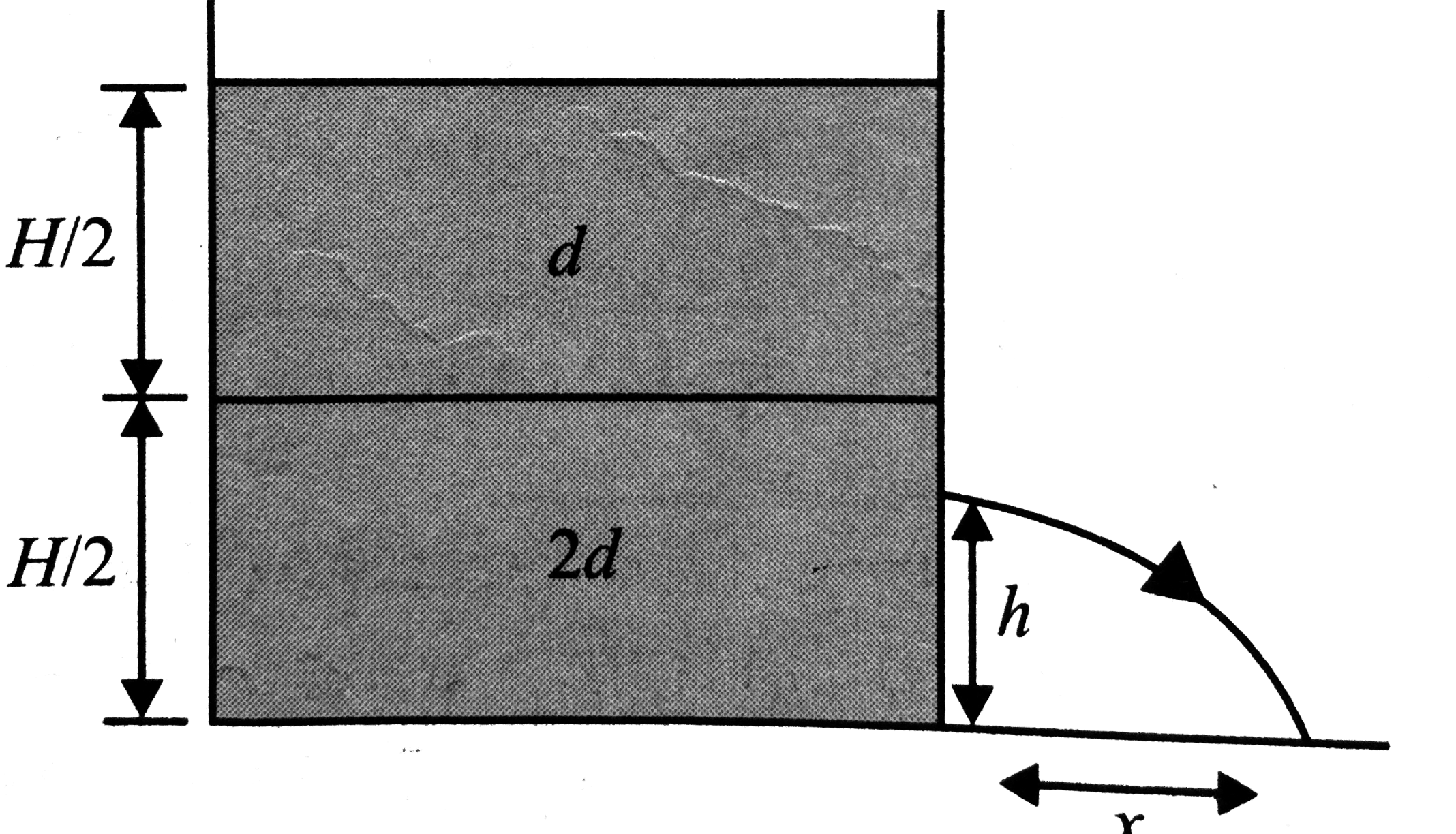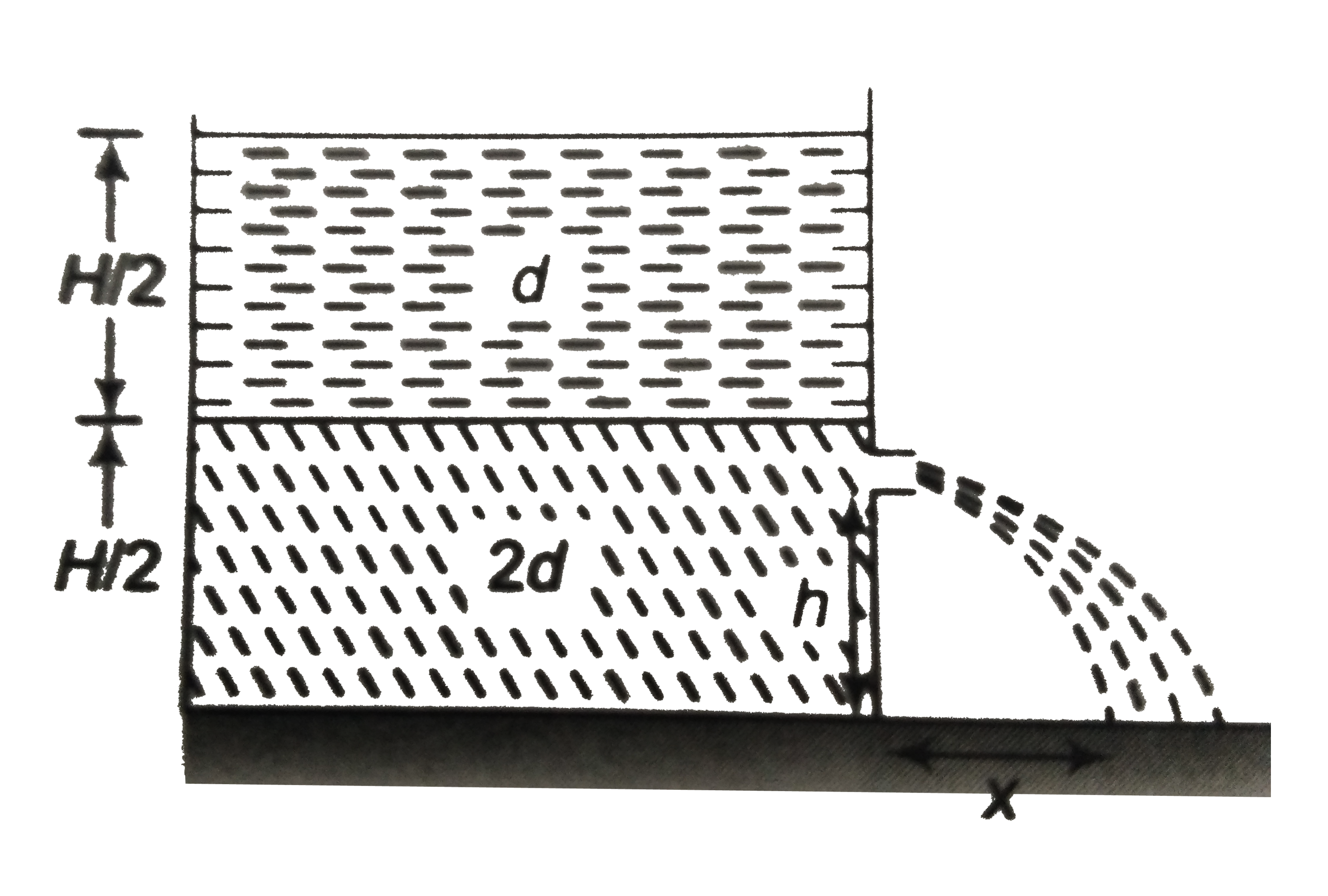Two non-mixing liquids of densities and are put in a container. The height of each liquid is . A solid cylinder of length and density is put in this container. The cylinder floats with its axis vertical and length in the denser liquid. The density is equal to :
The correct Answer is:c
To solve the problem, we will follow these steps:
Step 1: Understand the setup
We have two non-mixing liquids with densities ρ (upper liquid) and nρ (lower liquid, where n>1). A solid cylinder of length L and density d is placed in this container. The cylinder floats vertically with a length pL (where p<1) submerged in the denser liquid.
Step 2: Write the expression for the weight of the cylinder
The weight W of the cylinder can be expressed as:
W=d⋅V⋅g
where V is the volume of the cylinder, which can be expressed as A⋅L (where A is the cross-sectional area of the cylinder). Thus, we have:
W=d⋅A⋅L⋅g
Step 3: Write the expression for the buoyant force
The buoyant force FB acting on the cylinder is equal to the weight of the liquid displaced by the submerged part of the cylinder. The total buoyant force can be expressed as the sum of the buoyant forces from both liquids.
1. Buoyant force from the upper liquid (height L−pL=(1−p)L):
FB1=ρ⋅A⋅(1−p)L⋅g
2. Buoyant force from the lower liquid (height pL):
FB2=nρ⋅A⋅pL⋅g
Thus, the total buoyant force FB is:
FB=FB1+FB2=ρ⋅A⋅(1−p)L⋅g+nρ⋅A⋅pL⋅g
Step 4: Set the weight equal to the buoyant force
Since the cylinder is floating, the weight of the cylinder is equal to the total buoyant force:
d⋅A⋅L⋅g=ρ⋅A⋅(1−p)L⋅g+nρ⋅A⋅pL⋅g
Step 5: Cancel common terms
We can cancel A, L, and g from both sides:
d=ρ(1−p)+nρp
Step 6: Simplify the equation
Now, we can simplify the equation:
d=ρ(1−p+np)
d=ρ(1+p(n−1))
Step 7: Final expression for density d
Thus, the density d of the cylinder can be expressed as:
d=ρ(1+p(n−1))
Conclusion
The density d of the cylinder is given by:
d=ρ(1+p(n−1))
We have two non-mixing liquids with densities ρ (upper liquid) and nρ (lower liquid, where n>1). A solid cylinder of length L and density d is placed in this container. The cylinder floats vertically with a length pL (where p<1) submerged in the denser liquid.
The weight W of the cylinder can be expressed as:
W=d⋅V⋅g
where V is the volume of the cylinder, which can be expressed as A⋅L (where A is the cross-sectional area of the cylinder). Thus, we have:
W=d⋅A⋅L⋅g
The buoyant force FB acting on the cylinder is equal to the weight of the liquid displaced by the submerged part of the cylinder. The total buoyant force can be expressed as the sum of the buoyant forces from both liquids.
FB1=ρ⋅A⋅(1−p)L⋅g
FB2=nρ⋅A⋅pL⋅g
FB=FB1+FB2=ρ⋅A⋅(1−p)L⋅g+nρ⋅A⋅pL⋅g
Since the cylinder is floating, the weight of the cylinder is equal to the total buoyant force:
d⋅A⋅L⋅g=ρ⋅A⋅(1−p)L⋅g+nρ⋅A⋅pL⋅g
We can cancel A, L, and g from both sides:
d=ρ(1−p)+nρp
Now, we can simplify the equation:
d=ρ(1−p+np)
d=ρ(1+p(n−1))
Thus, the density d of the cylinder can be expressed as:
d=ρ(1+p(n−1))
The density d of the cylinder is given by:
d=ρ(1+p(n−1))
Similar Questions
Two immiscible liquid of densities rho and 3ρ are put in a container. The height of each liquid is h. A solid cylinder of length L and density d is put in this container. The cylinder floats completely inside liquids with its axis vertical and length L3 in the denser liquid. The density d is equal to
View SolutionIf two liquids of same mass but densities ρ1 and ρ2 respectively are mixed, then the density of the mixture is:
View SolutionIf liquid of density ρ is filled in an open cylindrical container to height h, then pressure at bottom
View SolutionA container of large uniform cross-sectional area A resting on a horizontal surface, holes two immiscible, non-viscous and incompressible liquids of densities d and 2d each of height H/2 as shown in the figure. The lower density liquid is open to the atmosphere having pressure P0. A homogeneous solid cylinder of length L(L<H/2) and cross-sectional area A/5 is immersed such that it floats with its axis vertical at the liquid-liquid interface with length L/4 in the denser liquid,
The density D of the material of the floating cylinder is View Solution
View SolutionFluids at rest exert a normal force to the walls of the container or to the sruface of the Body immersed in the fluid. The pressure exerted by this force at a point inside the liqid is the sum of atmospheric pressure and a factor which depends on the density of the liquid, the acceleration due to gravity and the height of the liquid, above that point. The upthrust acting on a body immersed in a stationary liquid is the net force acting on the body in the upward direction. A number of phenomenon of liquids in motion can be explain by Bernoulli's theorem which relates the pressure, flow speed and height for flow of an ideal incompressible fluid.
A container of large uniform corss sectional area. A resting on a horizontal surface holds two immiscible, non viscous and incompressile liquids of densities d and 2d, each of height H/2 as shown in the figure. The lower density liquid is open to the atmosphere having pressure P0.
Situation I:
A homogeneous solid cylinder of length L(L<H/2). cross sectional area A/5 is immersed such that it floats with its axis vertical at liquid -liquid interface with lenght L/4 in the denser liquid.
The density of the solid isView SolutionA container of a large uniform cross-sectional area A resting on a horizontal surface holds two immiscible, non viscous and incompressible liquids of densities d and 2d, each of height H/2 as shown in figure. The lower density liquid is open to atmosphere. A homogeneous solid cylinder of length L(L<H2), cross-sectional area A/5 is immersed such that it floats with its axis vertical of the liquid-liquid interface with length L/4 denser liquid. Determine
(a) density D of the solid and
(b) the total pressure at the bottom of the container. (Atmospheric pressure =P0).
 .View Solution
.View SolutionA container of large uniform cross-sectional area A resting on a horizontal surface, holes two immiscible, non-viscon and incompressible liquids of densities d and 2d each of height H/2 as shown in the figure. The lower density liquid is open to the atmosphere having pressure P0. A homogeneous solid cylinder of length L(L<H/2) and cross-sectional area A/5 is immeresed such that it floats with its axis vertical at the liquid-liquid interface with length L/4 in the denser liquid,

The cylinder is then removed and the original arrangement is restroed. a tiny hole of area s(s<<A) is punched on the vertical side of the container at a height h(h<H/2). As a result of this, liquid starts flowing out of the hole with a range x on the horizontal surface.
The initial speed of efflux without cylinder isView SolutionA solid cylinder of length L is in equilibrium in two different liquid A and B as shown in the figure.The density of liquid A 3ρ2 and liquid B is 3ρ.The density of cylinder is
View SolutionA container of large uniform cross-sectional area A resting on a horizontal surface, holes two immiscible, non-viscon and incompressible liquids of densities d and 2d each of height H/2 as shown in the figure. The lower density liquid is open to the atmosphere having pressure P0. A homogeneous solid cylinder of length L(L<H/2) and cross-sectional area A/5 is immeresed such that it floats with its axis vertical at the liquid-liquid interface with length L/4 in the denser liquid,

The cylinder is then removed and the original arrangement is restroed. a tiny hole of area s(s<<A) is punched on the vertical side of the container at a height h(h<H/2). As a result of this, liquid starts flowing out of the hole with a range x on the horizontal surface.
The initial value of x isView SolutionA needle of length l and density ρ will float on a liquid of surface tension σ if its radius r is less than or equal to:
View Solution

